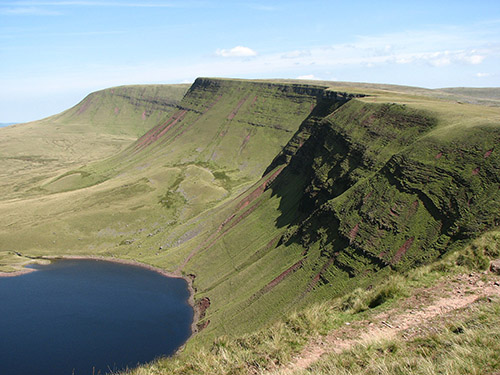We’re off to the gorgeous surroundings of the Bannau Brycheiniog (Brecon Beacons) this week for the Folklore of Mountains and Hills.
There’s also a lovely link with my focus on Northumberland last week. Where the Northumberland National Park and most of Kielder Water & Forest Park are an International Dark Sky Park, the Bannau Brycheiniog National Park is Wales’ only International Dark Sky Reserve. Long may we cherish these sites where we can wonder at our night sky.
Until earlier in 2023, most knew the national park as the Brecon Beacons. But here’s the thing. No one actually changed the park’s name to Bannau Brycheiniog. That was always its Welsh name since the park came into existence in 1957. And its first reference in writing in the early 16th century uses Bannau Brycheiniog (Thomas 2023). Thus the hills shall be called in this post.

Bannau comes from the word ‘ban’, which means ‘peak’. Bannau is its plural. Brycheiniog comes from Brychan, a king in the 5th or 6th century. According to medieval folklore, he had many children, including Dwynwen, the Welsh patron saint of love (Thomas 2023). The lore also claims he was Irish, and while little is known for definite about Brychan, Rebecca Thomas notes evidence of an Irish influence on the area during the Middle Ages (2023).
The park is actually made up of the Bannau Brycheiniog mountains, which are the highest in southern Britain. Three more ranges surround them, so there are plenty of mountains in this area. The highest point in Bannau Brycheiniog is Pen y Fan, at 886m above sea level. According to Marie Trevelyan, so it’s unclear how common this belief was, dragons and flying serpents could be found among the Bannau Brycheiniog (1909: 168).
Fairies are more common, so let’s go and explore some fairy legends…
The Old Woman of the Mountains
The Welsh mountains have their own fairies, called the Gwyllion. Wirt Sikes describes them as “female fairies of frightful characteristics”, explaining that they “haunt lonely roads in the Welsh mountains, and lead night-wanderers astray” (1880). Mhara Starling describes them as “the spirits of the untamed wilds of the Welsh mountainous regions” (2022: 133).
Sikes referred to one of these gwyllion as the Old Woman of the Mountain. She took the form of a poor old woman, wearing a four-cornered hat, with her apron thrown over her shoulder. Anyone who saw her at night, or on a misty day, always lost their way.

To further compound the lost person’s terror, they would see her ahead of them, and assume she was a real person who could help set them right. They would hurry to catch her, although she never looked back and they could never catch her up. One man, named Robert Williams, apparently endured such an encounter on the Black Mountain in the national park. He ended up stumbling into a marsh, at which point he heard a vicious cackle. He realised the Old Woman might be a gwyll and drew his knife. The Old Woman vanished; Sikes suggests this is due to the fairies’ fear of knives, though it could also be a dislike of iron (1880).
The Fairy Bride of Llyn y Fan Fach
Llyn y Fan Fach lies within the national park and is the site of a legend of a fairy woman. According to one version of the story, a mortal man encounters the woman who emerges from the lake (Gwyndaf 1992/1993). Entranced by her beauty, he tried offering her his bread, but she refused, saying it was too hard, and she returned to the water. Dejected, the farmer went home and told his mother what had happened.
Following her advice, the next day, he returned with unbaked bread (so, dough). The girl again declined, this time saying the bread was too moist.

The farmer told his mother, and the next day, she sent him back to the lake with half-baked bread. He waited until almost sunset, disappointed that she didn’t come back. Just as he was about to give up, the fairy girl appeared. This time, she agreed to be his wife. She gave only one condition – that she would leave if he struck her three times without cause.
There are variations, in which the girl’s father makes him choose between his identical daughters to test the farmer’s love. But the couple married, and she brought with her a dowry of fairy animals, including cattle. Surprisingly for a fairy story, they lived happily and had three sons.
It Goes Wrong
One day, they were heading to a christening, and the farmer went to fetch his wife’s gloves while she fetched a pony. When he came back outside, she still stood where he’d left her. He tapped her on the shoulder with one of the gloves. This was strike 1.
The next occurred at a wedding. The fairy wife burst into tears, and the farmer hurried over to find out why. He tapped her on the shoulder to get her attention. This was strike 2.
The farmer seemed to get the message until many years later at a funeral. The wife suddenly began laughing, and the farmer touched her arm, asking her to mind where she was. The wife stopped laughing, reminded him of her condition, and left. She and all the animals she’d brought as part of her dowry walked into Llyn y Fan Fach.

The fairy woman didn’t disappear entirely. She reappeared to her sons and taught them how to heal the sick. She revealed the healing properties of plants, and they went on to become the Physicians of Myddfai. So while the story didn’t end happily for the couple, the sons wrote down what they’d learned, and thus passed on their knowledge to their descendants.
Llyn Cwm Llwch
Llyn Cwm Llwch lies near Pen y Fan and Corn Du. It might seem odd to focus on lakes in an episode about mountains and hills, but these two lakes are an intrinsic part of the Bannau Brycheiniog.
One legend spoke of an old woman of the lake. Apparently, she preyed on those who were trusting or gullible. Children were an easy target. Like other creatures that found ways to lure her victims into water, the old woman had a favourite method – music. This had the advantage of grabbing their attention, as well as luring them to their doom.

Where other water creatures like the kelpie or Jenny Greenteeth seemed to drown people as either food or for fun, the old woman apparently had a different motivation. According to the legend, she needed to drown 900 victims to regain her beauty and to achieve immortality (Evans 2017).
The May Day Door
In one legend, a doorway appeared in a rock beside the lake every May Day (Jenkyn 1908). If you were brave enough to pass through, you’d find yourself in a passage. It led to an enchanted garden on an island in the middle of the lake.
If you’re saying, “but there is no island in the lake”, then that’s part of the magic. Those on the island could see the lake shore, but those on the shore couldn’t see the island.

The legend continued that the garden boasted gorgeous flowers, beautiful butterflies, and songbirds in the trees. The island, and the garden, belonged to the Tylwyth Teg, the Welsh fairy folk.
They would entertain mortal visitors with songs and stories. Humans could also safely go home, but on one condition. They couldn’t take anything from the garden or island with them. Sounds fair.
But as the legend explained, one visitor didn’t heed their condition. Despite the wonderful time he’d had as their guest, he wanted more. He took a flower as a souvenir of his time there. He dropped down dead as soon as he re-emerged on the lake shore.
The door never appeared again.
The Giant
There is another legend of Llyn Cwm Llwch. According to E. Sidney Hartland, the locals decided to drain it long ago. They’d almost finished their work when a tempest whipped up around them. A huge figure rose up from the middle of the lake, his hair and beard some three yards long. With a furious glare, he ordered them to stop their work. If they didn’t, he would drown the vale of Usk and the town of Beacon (1888: 203). Given the lake is still there, we can only assume they agreed.
Now, this legend actually appears in a different form and links to the mysterious door. In this variation, the locals remembered the door, even though no one had seen it for a century. They wondered if the Tylweth Teg left any treasure behind, and contrived to drain the lake to look for it (Jenkyn 1908).

As in Hartland’s version, the giant rose out of the water during the sudden tempest and issued his threat if they continued in their work. Yet in the longer version, the giant also warned them to “remember the token of the cat!”
This meant nothing to most of the locals, although one old man came forward to explain. According to him, someone asked him to drown a tomcat that had become a nuisance in the area. The man did as he was asked, and drowned the cat in Llyn Cym Llych. The next day, he went fishing on Llyn Syffaddon, and spotted the dead cat, still in its bag, floating in the lake. The two lakes were not connected as far as they knew, but they feared an underground link between the two lakes. The men decided it was safer to leave the treasure, and the lake, alone, and went home (Jenkyn 1908).
The giant kept his promise and didn’t flood Brecon or the valley.
Folklore in the Bannau Brycheiniog
The legends here are perhaps the most famous ones you’ll encounter about the area. But they’re a good indication of the ways in which Welsh fairy lore differs from English fairy lore. I recommend Mhara’s book for more details on Welsh fairies.
It would be easy to assume the Old Woman of the Mountain and the old woman of Llyn Cwm Llwch were cautionary tales. Perhaps they were helpful advice to travellers on the mountain at night or in the mist. And they may have helped keep children away from deep water.
But as with all things folklore, there’s always the possibility there’s more to them than meets the eye. Especially in a land as magical as Wales!
Which is your favourite legend from the Bannau Brycheiniog?
References
Evans, Zteve T (2017), ‘Welsh Lake Legends and Folklore: Llyn Cwm Llwch and the Door of the Tylwyth Teg’, Folklore Thursday, https://folklorethursday.com/legends/legends-welsh-lakes-llyn-cwm-llwch-door-tylwyth-teg/.
Gwyndaf, Robin (1992), ‘A Welsh Lake Legend and the Famous Physicians of Myddfai’, Béaloideas, 60/61, pp. 241–266.
Hartland, E. Sidney (1888), ‘THE PHYSICIANS OF MYDDFAI (Continued)’, The Archaeological Review, 1 (3), pp. 196–203.
Sikes, Wirt (1880), British Goblins: Welsh Folk-lore, Fairy Mythology, Legends and Traditions, London: S. Low, Marston, Searle & Rivington.
Starling, Mhara (2022), Welsh Witchcraft: A Guide to the Spirits, Lore, and Magic of Wales, Woodbury, MN: Llewellyn (affiliate link).
Thomas, Rebecca (2023), ‘The long history of Bannau Brycheiniog – the true name of the Brecon Beacons for centuries’, The Conversation, https://theconversation.com/the-long-history-of-bannau-brycheiniog-the-true-name-of-the-brecon-beacons-for-centuries-203951.
Thomas, W. Jenkyn (1908), The Welsh Fairy Book, New York: F. A. Stokes.
Trevelyan, Marie (1909), Folk-Lore and Folk-Stories of Wales, London: Elliot Stock.
Wood, Juliette (1992), ‘The Fairy Bride Legend in Wales’, Folklore, 103 (1), pp. 56–72.
Nutty about folklore and want more?
Add your email below and get these posts in your inbox every week.
You'll also get my 5-step guide to protecting your home using folklore!






brilliant as ever